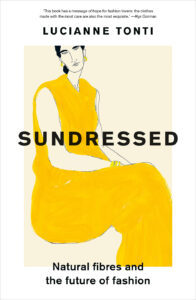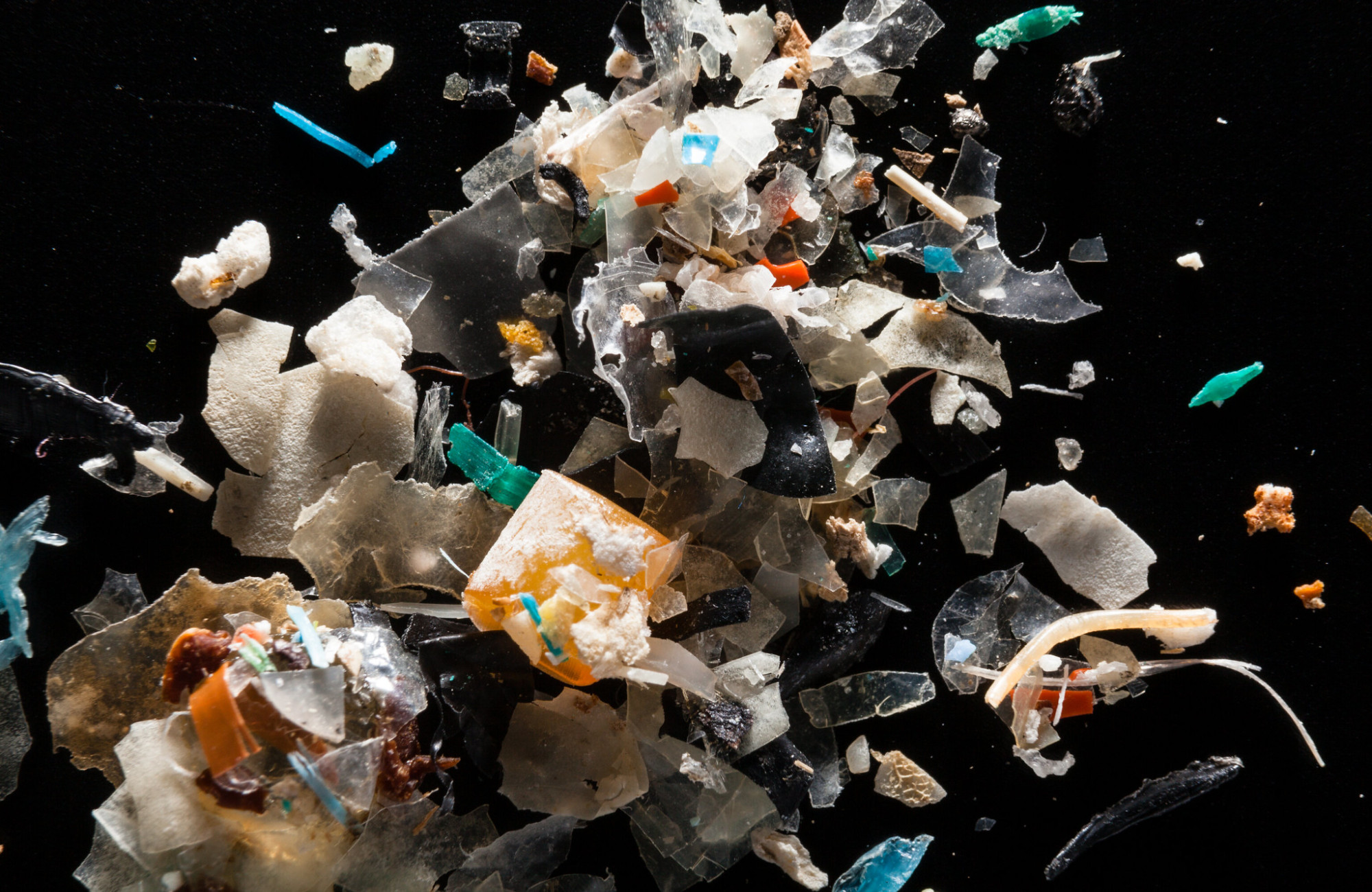“I love my clothes,” begins Lucienne Tonti, in the first line of her book Sundressed, Natural Fabrics and the Future of Clothing. “On a good day, they make me feel beautiful. On a bad day, they help me feel composed.”
This might seem a somewhat superficial or solipsistic start to a book addressing systemic – even existential – problems like plastic pollution, waste and overproduction, industrial agriculture, and environmental harm in supply chains. But there is power in this message. Clothes have a particular hold over how we feel and, increasingly, people’s clothes are not making them feel beautiful, or composed, but guilty.
The issues above are not unique to the fashion industry. Plastic is everywhere (literally). Planned obsolescence and disposability span most consumer products. Few international supply chains are free of human rights abuses, waste, and carbon emissions. But emotions conquer rationality on the high street – even when shopping with climate change in mind – and so fashion brands face more pressure over sustainability than other industries. People can ignore the ethical credentials of their fridge, phone, or foam mattress, but they want to love their clothes.
This is a good thing – the clothing industry has opportunity to pave the way for others. An enlarging majority of people now want to prioritise ethical and environmental standards over brand-recognition and trendiness. In some regions – like Hong Kong – consumers are even willing to pay significantly more for genuinely sustainable clothing.
But brands must do more to earn our love than plaster sustainable buzzwords onto shop walls: recent UK research found the public viewed fashion companies as the least trustworthy sector on climate claims, apart from airlines. As Tonti admits early on in Sundressed, “the use of the word sustainable and its counterparts – conscious, eco, natural, positive impact, zero waste – has become so ubiquitous, so overused in PR marketing campaigns, that they have lost their meaning. Or in fact, their meaning is so deliberately vague that the truth about a garment’s impact is successfully obscured.”
0 easy tips to dress sustainably in 2023
Sundressed is a gentle antidote to the ever-inflating flood of podcasts, vlogs, shorts, lectures and listicles that litter our internet ecosystems with tips and tricks to dress ethically. It’s not a how-to guide for shoppers, but agricultural analysis for fashion enthusiasts, in magazine prose. Fashion cannot change until farming does.
Tonti’s future for clothing is natural, localised, and based on regenerative farming practice. No synthetics, no chemicals, and no monocultures stretching to the horizon. This would not only help nature and climate, but how we feel about our clothes too, both physically and emotionally. 80% of clothes are now made with new plastic, but the oil in plastics traps sweat and stains and “won’t let go”.
“That’s why you’ll notice that polyester clothes smell when you wear them over and over again. That’s why you can’t get stains out of a polyester top. Even when they’re clean, they’ll still stink.”
Modern clothing also degrades quickly, often irreparably. Fast fashion lifestyles have become unavoidable. “It’s worth remembering that before “fast fashion”, clothes were made to last. They were worn, re-worn, and repaired.” Why would anyone allow themselves to love things they know they will throw away? We are given an illusion of never-ending choice, while denied the choices available to all generations before us.
The book is honest about the scale of these problems – the first chapter is titled ‘There is no such thing as sustainable fashion’ – and shies away from ranking brands or recommending certifications. Many certifiers are voluntary, and the resulting lack of oversight makes them “tantamount to greenwashing.” Some are described as “opaque and corrupt”, which is why “much of the ‘organic’ cotton on the market may not be organic at all.”
What are the fabrics of the future?
So polyester and nylon are out: what makes the cut? Beginning with anecdotes about Tonti’s career and wardrobe, and ending with wider musings on what needs to change at a global level, Sundressed’s chapters are essay-like discussions of different materials. In each case, interviews with farmers alongside descriptions of their ranch, vineyard, or plantation not only show how farms need to change, but act as case studies proving these changes are possible.
Merino wool and Mongolian cashmere pass the Tonti test, but must be grazed differently to avoid desertification. Cotton and silk should be farmed without tilling and pesticides, using varied cover crops and compost made from readily available (and nutrient-rich) materials like fungi, bean pulp, and silkworm excrement.
Flax for linen “thrives with minimal intervention and can be grown without fertilizers, herbicides, fungicides, regulators, or irrigation.” As long as meat remains on our menus, leather’s in the clear. Hemp is overdue a comeback, as is high quality denim (not only have our jeans become less durable, but mixing denim with elastane and polyester prevents them from being recycled).
Similarly to Matt Simon in his book on plastic pollution, Tonti is skeptical of viscose alternatives to polyester and nylon, made from plants and trees. She gives some credit to Lenzing for attempts to improve Lyocell, but does not refrain from detailing their history developing the material in forced labour camps for the Nazis during World War II. Rayon and viscose fabrics still pose risks regarding worker rights, deforestation, pollution, and water usage, so ulimately, she said on our podcast, “I don’t believe we should be wearing clothes made from trees.” And, regardless, cotton creates better quality fibre.
The plastic generation, or the plastic age?
Clothes do not just affect how we feel about ourselves, but could shape how other generations feel about us too. When archaeologists recently discovered the 7000-year-old microscopic remains of cotton fibres in an ancient rubbish dump in Israel, they proved the existence of prehistoric trading routes with what is now Pakistan, and provided insight into early farming methods in the Indus Valley.
Studying the clothes industry will always go hand-in-hand with studying agriculture and trade. Tonti understands this, and Sundressed contains occasional criticisms of free trade agreements in the 1990s and 2000s which “slashed protections for the clothing and footwear industries”, waiving environmental regulation to allow companies to cheaply internationalise their supply chains. But ultimately, the book gives a rich understanding of agricultural practices, but little discussion of protectionism, or the extent to which the clothes industry must deglobalise, or how much farming can change if it doesn’t.
Can we make these changes in time for 2050 climate targets? If someone finds a microfibre from your clothes seven millennia from now, will it be an archaeologist discovering obscure, forgotten trade routes, or will they still be cleaning up the mess from the Global Plastic Age?
We have strong feelings about clothes because we express our identity through them. They express our desires, conceal our secrets, communicate our wealth and interests, both at a personal and societal level. Each microfibre thread we shed into the wash or vacuum off our floors contains the shames and successes of our era: a society both powered by and made of crude oil, where the quality of our life, environment and products are all sacrificed to market pricing, and supply chains form illogical criss cross patterns across the planet.
That vision is a generation’s fossil record, unchangeable and permanent, but whether future archaeologists treat it as a rare find or just ancient garbage is for us to dictate this century. Sundressed leaves the question open, but it goes some way to proving reform is possible, and where best to begin.
Bertie Harrison-Broninski is the Assistant Editor at Land and Climate Review, and an investigative researcher for Culmer Raphael. Find him on Twitter @bertrandhb, and view his portfolio here.
Read more:
- Materials






